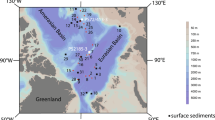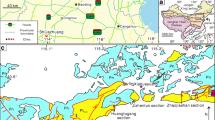Abstract
Low-Mg calcite shells have been widely used to reconstruct the chemistry of ancient seawater. There is always a question: are the shells chemically pristine? This paper presents the isotope and elemental geochemistry of low-Mg calcite bivalve shells in late Miocene platform carbonates, SE Spain. The platform carbonates were extensively dolomitized, and limestone is restricted to older stratal units, and to units mainly in topographically higher and more landward strata. Low-Mg calcite oyster shells were completely dissolved out in the basinward dolomite, but are well preserved in the limestone. These shells appear to retain the original growth microstructures, based on hand samples. Under the microscope, however, dissolution and recrystallization, as well as pristine growth lines are all present. Sr isotopes in these shells range from that of normal Miocene seawater to radiogenic values. δ18O and δ13C values, and Mg, Sr, and Na concentrations in these shells are rather variable. The high end members are consistent with the typical values of modern/late Miocene normal-seawater low-Mg calcite shells, whereas the low end members are close to those of diagenetic calcite cements, which have low δ18O, δ13C, Sr and Na values, and radiogenic Sr. The Nijar shells were altered physically and chemically to different degrees by diagenesis, although these shells are consistent with some “criteria” of unalteration. The isotopic and trace-element data collected in altered and pristine (or less altered) portions coexisting in the same shells are clearly differentiable. Quantitative simulation of covariations of geochemical pairs indicates that solid mixing of unaltered and altered portions by sampling is consistent with the variations in isotopic and elemental data recorded in the Nijar shells. The geological significance of this study is that ancient fabric-retentive calcite shells may have been altered geochemically although they may appear pristine. Calcite shells that underwent intensive diagenesis should be examined rigorously under the microscope, coupled with investigations of multiple geochemical proxies to assess chemical alteration. Only the data of unaltered shells can be used to reconstruct the chemistry of ancient seawater.
Similar content being viewed by others
References
Addicott B, Snavely P, Bukry D, Poore R (1978) Neogene stratigraphy and paleontology of Southern Almeria Province, Spain: an overview. US Geol Surv Bull 1454:1–49
Banner JL, Hanson G (1990) Calculation of simultaneous isotopic and trace element variations during water-rock interaction with applications to carbonate diagenesis. Geochim Cosmochim Acta 54:3123–3137
Brand U (2004) Carbon, oxygen and strontium isotopes in Paleozoic carbonate components: an evaluation of original seawater-chemistry proxies. Chem Geol 204:23–44
Brand U, Logan A, Hiller N, Richardson J (2003) Geochemistry of modern brachiopods: applications and implications for oceanography and paleoceanography. Chem Geol 198:305–334
Dabrio CJ, Esteban M, Martin JM (1981) The coral reef of Nijar, Messinian (Uppermost Miocene), Almeria Province, SE Spain. J Sed Petrol 51:521–539
Epstein S, Graf DA, Degens ET (1964) Oxygen isotope studies on the origin of dolomites. In: Craig H, Miller SL, Wasserburg GJ (eds) Isotopic and cosmic chemistry. Elsevier, Amsterdam, pp 169–180
Esteban M (1979) Significance of the upper Miocene coral reefs of the western Mediterranean. Palaeogeogr Palaeoclimatol Palaeoecol 129:169–188
Fouke B (1993) Chronostratigraphy and dolomitization of the Seroe Domi Formation, Curacao, Netherlands Antilles. PhD Dissertation. SUNY, Stony Brook
Franseen EK, Mankiewicz C (1991) Depositional sequences and correlation of middle (?) to late Miocene carbonate complexes: Las Negras and Nijar areas, southeastern Spain. Sedimentology 38(5):871–898
Friedman I, O’Neil JR (1977) Compilation of stable isotope fractionation factors of geochemical interest. US Geol Surv Prof Pap 440K:1–12
Gillikin DP, De Ridder F, Ulens H, Elskens M, Keppens E, Baeyens W, Dehairs F (2005) Assessing the reproducibility and reliability of estuarine bivalve shells (Saxidomus giganteus) for sea surface temperature reconstruction: implications for paleoclimate studies. Palaeogeogr Palaeoclimatol Palaeoecol 228:70–85
Goodwin D, Schöne B, Dettman D (2003) Resolution and fidelity of oxygen isotopes as paleotemperature proxies in bivalve mollusk shells: models and observations. Palaios 18:110–125
Habermann D, Neuser RD, Richter DK (1998) Low limit of Mn+2-activated cathodoluminescence of calcite: state of the art. Sed Geol 116:13–24
Hanshaw BB, Back W, Deike RG (1971) A geochemical hypothesis for dolomitization by groundwater. Econ Geol 66:710–724
Hodell DA, Benson RH, Kennett JP, Rajic-El Bied K (1989) Stable isotope stratigraphy of latest Miocene sequences in northwest Morocco: the Bou Regrey section. Paleoceanography 4:469–482
Keith ML, Weber JN (1965) Systematic relationship between carbon and oxygen isotopes in carbonates deposited by modern corals and algae. Science 150:498–501
Kingston AW, Gröcke DR, Burchell M (2008) A multiaxial growth analysis of stable isotopes in the modern shell of Saxidomus gigantea: implications for sclerochronology studies. Geochem Geophys Geosyst 9:Q01007 doi: 10.1029/2007GC001807
Klein RT, Lohmann KC, Thayer CW (1996) Sr/Ca and 13C/12C in skeletal calcite of Mytilus trossulus: covariation with metabolic rate, salinity, and carbon isotope composition of seawater. Geochim Cosmochim Acta 60:4207–4221
Krantz DE (1990) Mollusk-isotope records of Plio-Pleistocene marine paleoclimate, U.S. Middle Atlantic coastal plain. Palaois 5:317–335
Land LS (1980) The isotope and trace element geochemistry of dolomite: the state of art. In: Zenger DH, Dunham J, Ethington R (eds) Concepts and models of dolomitization. SEPM Spec Publ 28:87–110
Land LS (1983) The application of stable isotopes to the studies of the origin of dolomites and to problems of diagenesis of clastic sediments. In: Arthur MA, Scholle PA, Halley RA (eds) Stable isotopes in sedimentary geology. SEPM Short Course 10:4.1–4.22
Lee MR, Martin RW, Trager-Cowan C, Edwards PR (2007) Imagine of cathodoluminescence zoning in calcite by scanning electron microscopy and hyperspectral mapping. J Sed Res 75:313–322
Lerman A (1965) Paleoecological problems of Mg and Sr in biogenic calcites in light of recent thermodynamics data. Geochim Cosmochim Acta 29:977–1002
Lloyd RM (1964) Variations in the oxygen and carbon isotope ratios of Florida Bay mollusks and their environmental. J Geol 72:84–111
Lu FH (2006) Water-body record and lithofacies of Messinian evaporites in Nijar Basin, SE Spain. Sed Geol 188/189:115–130
Lu FH, Meyers (1998) Massive dolomitization of a late Miocene carbonate platform: a case of mixed evaporative brines with meteoric water, Nijar, Spain. Sedimentology 45:263–277
Lu FH, Meyers WJ (2003) 87Sr/86Sr, δ34S and δ18O (SO4) isotopes of Messinian evaporites, modeling and environmental significance. J Sed Res 73:443–449
Martin JM, Braga JC (1993) Discussion: Depositional sequences and correlation of middle (?) to late Miocene carbonate complexes, Las Negras and Nijar areas, southeastern Spain. Sedimentology 40(2):351–353
Meyers WJ, Lohmann KC (1985) Isotope geochemistry of regional extensive calcite cement zones and marine components in Mississippian limestones, New Mexico. In: Schneidermann N, Harris PM (eds) Carbonate cements. SEPM Spec Publ 36:223–239
Meyers WJ, Lu FH, Zachariah J (1997) Dolomitization by mixed evaporative brines and freshwater, late Miocene carbonates, Nijar, Spain. J Sed Petrol 67:898–912
Montenat C, Ott d’Estevou P, Masse P (1987) Tectonic-sedimentary characters of the Betic Neogene Basins evolving in a crustal transcurrent shear zone (SE Spain). Bull Centre Rech Prod Explor Elf-Aquitaine 11:1–22
Mook WG (1971) Paleotemperatures and chlorinities from stable carbon and oxygen isotopes in shell carbonate. Palaeogeogr Palaeoclimatol Palaeoecol 9:245–263
Ohde S, Kitano Y (1984) Coprecipitation of strontium with marine Ca-Mg carbonates. J Geochem 18:143–146
Owen R, Kennedy H, Richardson C (2002) Isotopic partitioning between shell calcite and seawater: effect of shell growth rate. Geochim Cosmochim Acta 66:1727–1737
Popp BN, Anderson TF, Sandberg PA (1986) Brachiopods as indicators of original isotopic compositions in some Paleozoic limestones. GSA Bull 97:1262–1269
Rahimpour-Bonab H, Bone Y, Moussavi-Harami R (1997) Stable isotope aspects of modern mollusks, brachiopods, and marine cements from cool-water carbonates, Lacepede Shelf, South Australia. Geochim Cosmochim Acta 61:207–218
Reed RM, Milliken KL (2003) How to overcome imaging problems associated with carbonate minerals on SEM-based cathodoluminescence systems. J Sed Res 73:328–332
Riding R, Braga J, Martin J (1991) Oolite stromatolites and thrombolites, Miocene, Spain: analogues of Recent giant Bahamian examples. Sed Geol 71:121–127
Rosenberg GD, Hughes WW (1991) A metabolic model for the determination of shell composition in the bivalve mollusc, Mytilus edulis. Lethaia 24:83–96
Rush PF, Chafetz HS (1990) Fabrics retentive, non-lumininescent brachiopods as indicators of original C and O composition: a test. J Sed Pet 60:968–981
Sheppard SMF, Schwarcz HP (1970) Fractionation of carbon and oxygen isotopes and magnesium between coexisting metamorphic calcite and dolomite. Contrib Mineral Petrol 26:161–198
Tanaka N, Monaghan MC, Rye DM (1986) Contribution of metabolic carbon to mollusk and barnacle shell carbonate. Nature 320:520–523
Van de Poel HM (1994) Messinian stratigraphy of the Nijar basin (S.E. Spain) and the origin of its gypsum-ghost limestones. Geol Mijnb 70:215–234
Van der Zwaan GJ, Gudjonsson L (1986) Miocene-Pliocene stable isotope stratigraphy and paleoceanography of the Mediterranean. Mar Micropaleontol 10:71–90
Veizer J (1983) Chemical diagenesis of carbonates: theory and application of trace element techniques. In: Arthur MA, Scholle PA, Halley RA (eds) Stable isotopes in sedimentary geology. SEPM Short Course 10:3.1–3.100
Wadleigh MA, Veizer J (1992) 18O/16O and 13C/12C in lower Paleozoic articulate brachiopods: oxygen and carbon isotopic records of Paleozoic oceans. Geochim Cosmochim Acta 50:1679–1696
Author information
Authors and Affiliations
Corresponding author
Rights and permissions
About this article
Cite this article
Lu, F.H. Pristine or altered: low-Mg calcite shells survived from massive dolomitization? A case study from Miocene carbonates. Geo-Mar Lett 28, 339–349 (2008). https://doi.org/10.1007/s00367-008-0110-x
Received:
Accepted:
Published:
Issue Date:
DOI: https://doi.org/10.1007/s00367-008-0110-x




